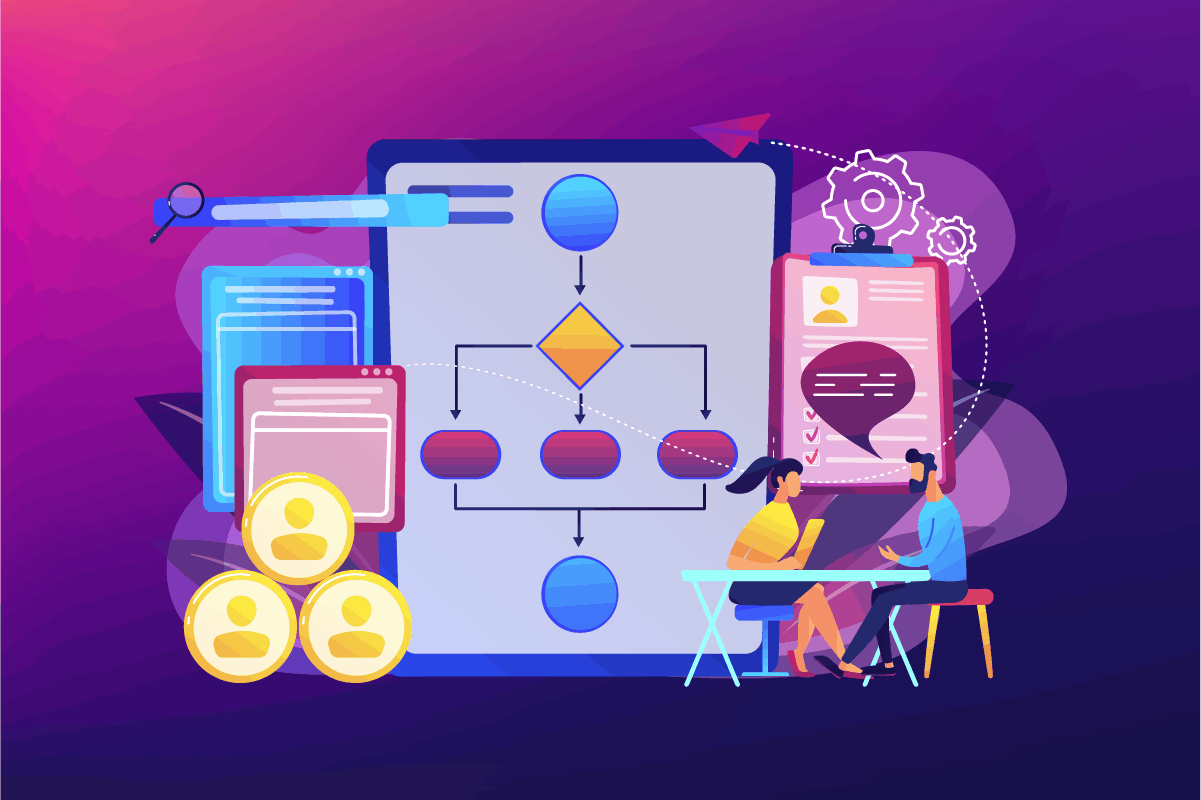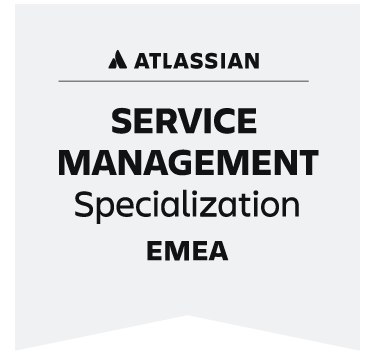"The biggest challenge I face right now is long lead times. Active candidates want a job NOW or as soon as possible. In my own company, the time to fill positions has increased from about a month to two months now. It's always difficult to retain the best candidates during that time period..."
- Glen Loveland, HR Manager, Global Talent Acquisition of CGTN
In many growing companies, a standardized and formal application process is needed. Among other things, to manage the effort of onboarding additional employees or hiring new ones. Part-time consultants, external recruiting firms or HR departments are often not an option for smaller companies due to the high costs involved. Therefore, it makes sense to get involved with HR management early on and build an internal application process, thus ensuring the next phase of the company's growth.
Each new application increases the administrative capacity. For small, growing companies, ways must therefore be found to manage this effort efficiently. One of the first tasks is to make the basic processes as efficient as possible. Choosing the wrong tools often requires a lot of manual effort. That's why the best approach would be to use software that automates much of the administrative work of the application process. In our opinion, one of the best tools to achieve this is Jira Service Management.
A quick note to all readers: If they've never heard of Jira Service Management, they should take a look at this Product Guide. It will give you a brief overview of the tool and how to use it: Jira Service Management & Ticketing.
How our solution works
Jira Service Management (JSM) is a versatile project management tool for departments such as finance, marketing, sales, and human resources. Among other things, HR managers can use Jira Service Management to recruit new employees, track applicant interviews, or manage applicant pools. Basically, JSM can be configured so that each new application automatically creates a ticket, which you can assign to individual employees or teams (e.g. HR). In doing so, your entire applicant management is greatly simplified with a visualized workflow. With this, you can also react quickly to comments on applications and adapt quickly to changes. For example, you can quickly ask applicants to submit work samples, references, etc. via the comment function. In Jira Service Management, you can: (1) Manage tasks and processes through workflows. (2) Show steps and status of a task in the workflow. (3) Customize the type and manner of the workflow. (4) Modify individual specific tasks or the entire flow of the workflow.
A standard Jira workflow might look like this:
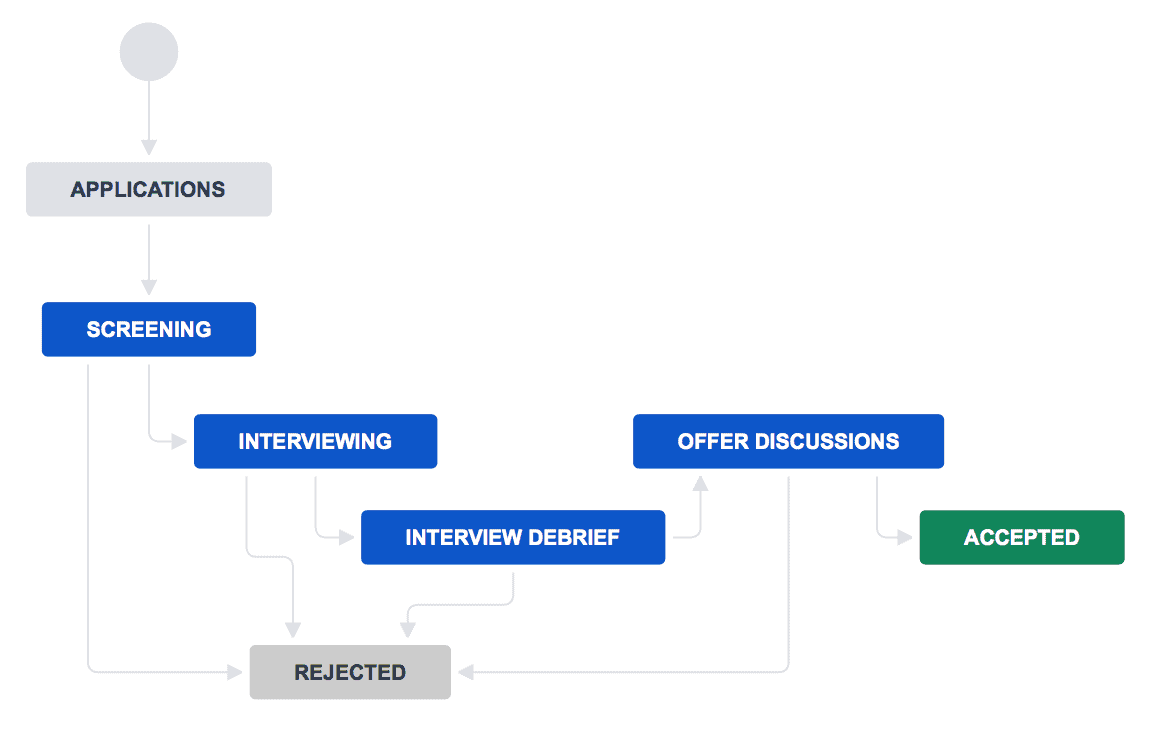
Here is a brief overview of what is possible with Jira Service Management and the benefits of using Jira for recruiting. Furthermore, we explain how we plan and manage our HR processes with the powerful Atlassian tool.
1. tracking of applicants
An important application for Jira in recruiting is applicant tracking. Tasks for applicants, such as uploading all important documents, are created automatically with it.
Depending on how you design your application process, you can set your candidate's ticket status to 'done' when the process is complete. If they still have other tasks to complete, such as background checks or administrative work, they can set the task to 'in progress'. In addition, special subtasks can be set up under 'in progress', such as 'call' or 'invite' if you want to get to know applicants better after the initial screening. Such tasks can be repeated each time a new candidate enters the application process.
2. manage relevant files
When recruiting for a job opening in your company, you often receive hundreds of applications with different attachments. With Jira, managing these documents is very convenient. All you have to do is select a specific ticket and click on the attachments icon. All relevant documents are added there automatically with an automated workflow.
Additionally, their team members responsible for recruiting can easily communicate the progress of an application in the comments section within a single ticket. Additionally, other team members can be mentioned in the internal comments, allowing for smooth and streamlined team communication.
3. creating an individualized Jira workflow
With Jira Service Management you can manage workflows, tasks and subtasks and complete them in parallel. Jira is a versatile tool that can be adapted to the requirements of your application process and your team. For example, the status workflow can be tailored to your process, even if it includes multiple intermediate steps (e.g. multiple interviews per applicant).
In addition, you can create a modifiable Kanban board to keep track of your recruiting stream and progress.
4. measure performance
Since Jira is a project management tool, you can accurately measure the performance of your workflows and your team members. For example, the average time from application to hire of your candidates. Thanks to the detailed reports, it's easy to identify potential bottlenecks and eliminate them before they become problems.
Formalizing and automating hiring workflows also leads to a more productive and satisfied workday for recruiters. With Jira, you ensure that your responsible team members can spend more time reviewing candidates, which also leads to better and more thoughtful candidate selection.
5. onboarding
Finally, you can also use Jira for the onboarding process of your new employees. We recommend that they customize and enhance their onboarding process in the Jira project with team-building events. You can easily record all important information, such as equipment provided or training results needed for onboarding.
How we implemented our Jira workflow
Over the past year, our teams have grown rapidly. The large number of new applications and onboardings has presented challenges for our HR specialists. As a result, we had to go through new applications every week, manually reviewing them and creating a series of identical topics and tasks. Ultimately, we decided to set up a new Jira workflow. In the workflow, several steps are automated, including the creation of various specific subtasks, descriptions and text templates.
First steps and basics
The first steps to setting up our workflow were: (1) Brainstorming about the various open positions in our company. (2) Planning out each step in our new Jira workflow. For the workflow, our IT and business development professionals pooled their knowledge. The result was: a workflow with individual processes in 5 superordinate steps as well as automated intermediate steps and required action fields. Here you can see a short excerpt from our workflow from the steps 1. application receipt and 2. application verification.
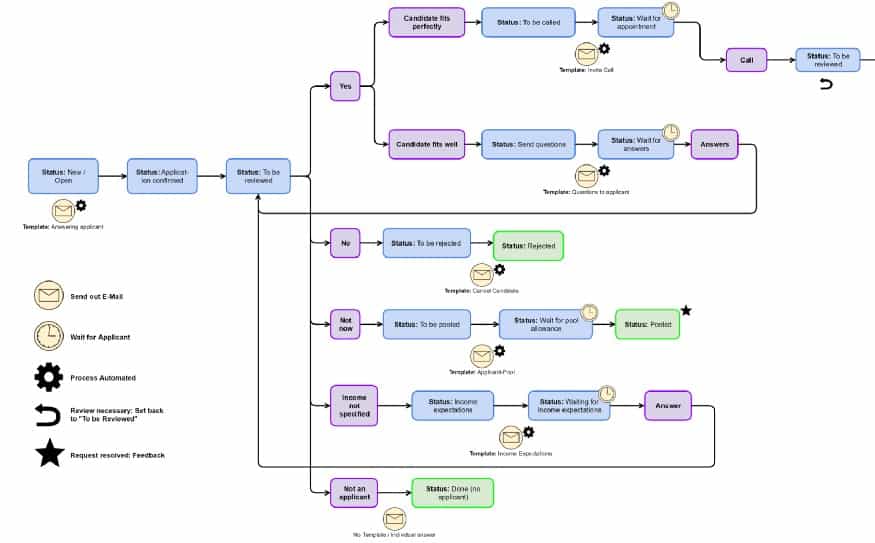
Despite the carefully thought-out steps, our workflow had some shortcomings at the beginning. After the first practical use, however, we were able to quickly identify these shortcomings and the workflow was adapted. This is another advantage of Jira: changing workflows and automations is quick and easy. Changes can be made at any time without having to adapt the entire project.
Creation of Jira workflow and Kanban board
Once you have defined your own workflow, it is time to integrate it into Jira. To do this, you first need to create a new project.
- Click on Projects > Show all projects
- Click in the upper right corner on Create project
- Select the basic project* > Enter the name and the key of the project
*We recommend using the base project. This offers the best possibilities to track, prioritize and resolve requests (or in other words: applications).
- Click on Boards > Show all boards
- Click on Create board in the upper right corner
- Select Kanban board > Board from an existing project select
- Enter the name and select the project you have just created for the board
After the board and project are created, click the Project Settings button. Here you can set automation, workflows, SLAs, and users and roles. We show an example of how we designed our workflow and Kanban board. We are happy to provide more information upon request. There is also detailed documentation on customizing workflows in Jira from Atlassian: Jira Workflow Overview
For the Kanban board in our Jira project we use 7 columns with a total of 22 Status. For a fast workflow it is important: (1) To choose a simplified workflow schema. (2) Create a cross link between the individual statuses. Thus, the status of each ticket in this workflow can be transferred to any other status. This creates flexibility, ease of use, and a simplified workflow for the Jira project. With the simplified workflow, the content of the Kanban board (including columns and statuses) can be changed at any time.
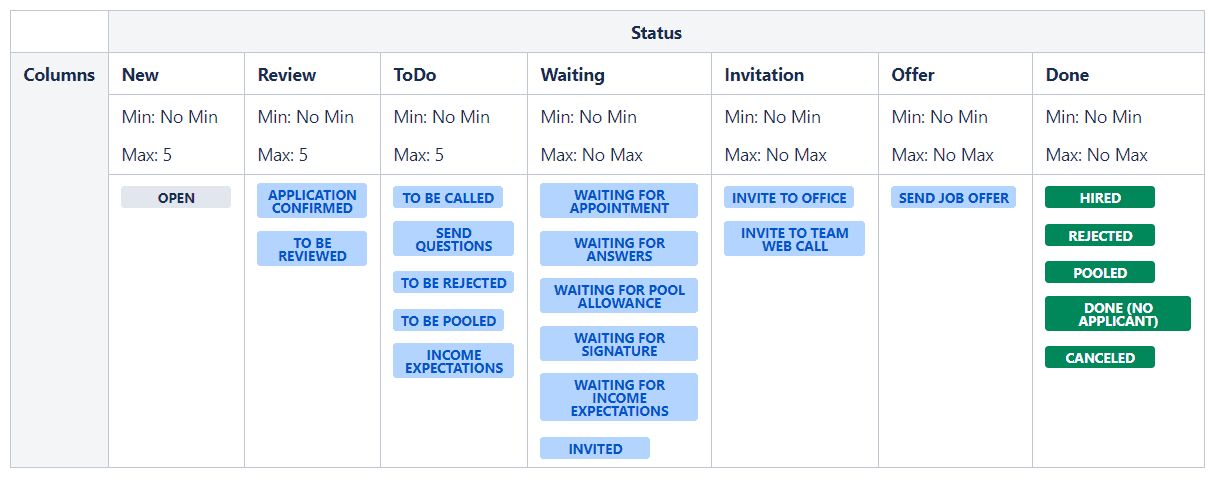
E-mail forwarding
After that, you have to define that all applications received as e-mail are automatically linked to the project. In other words, all email applications should automatically create a ticket in your configured project. To achieve this, you should integrate Jira with your email system. This setting can be configured under Project settings > E-mail request change. Make sure that you have the...
- Have permission to manage projects.
- enabled public logon or adding customers to your Service Desk project.
- have set up appropriate request types as required visible fields.
Click hereto learn more about receiving requests by email. See the following guide for the Email Troubleshooting if you encounter any problems while setting up the e-mail channel.
After the setup, the incoming applications are now transferred and automatically stored in Jira Tickets converted. This allows your team to focus on applicants immediately without having to manually deal with multiple inboxes.
Automation with Jira
Automation is one of Jira Service Management's greatest strengths. The simplest example is automation after receiving an application. When someone applies to your company, a ticket is created and the ticket is moved to the "New" column with an "Open" status. The goal of this automated process is to thank applicants for applying to us and let them know that we have received their documents and will review them in a timely manner.
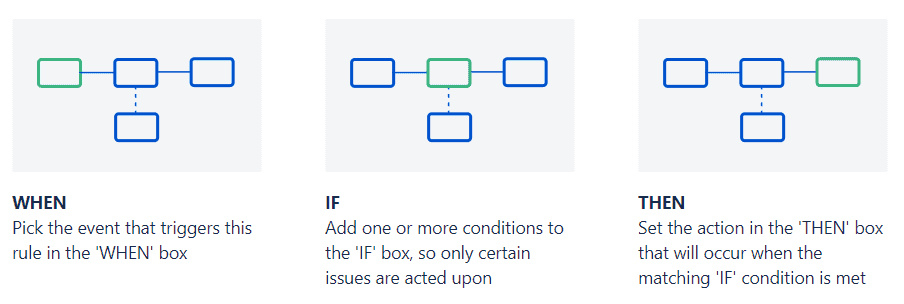
You can "If"-Trigger, "If."-conditions and "Then"-Add actions. These parameters determine the flow and generate the automation. The automation for receiving the application must be set as follows:
IF: Issue created OR status changed > IF: Issue matches status = Open > THEN: Send email = Template "Reply Applicant(s)" AND Change Issue = Request/Application confirmed AND Add comment = 'XALT Bot: Request/Application received and confirmed' AND Change Issue = Assignor changed to User XY AND Alert User = User XY
You can also additional automations as SLA (Service Level Agreement). This rule alerts you or the assigned person when SLAs are at risk, so you can keep track of time-critical issues. For example, assigned users can be alerted after a certain time if a request or application has not been processed within a given time. We set the SLA in our workflow to 16h and automation:
IF: SLA remaining time = at risk (30 min remaining time) > IF: Problem applies = all problems > THEN: Alert user = user XY
Individual adaptation for your benefit
Of course, application processes vary from company to company. Therefore, you should complete the following tasks so that our workflow fits your individual process:
- Customize the workflow to your application process. Pre-Screening, General, Shortlist
- Create an issue for each role and use subtasks to track candidates
- Customize the Kanban board to create the desired view of your HR stream
- Implement and use text templates and your CRM system
Conclusion
The benefits of Jira Service Management are extensive. Because Jira is, in contrast to other tools from the recruitment sector, very inexpensive (from 10USD/month) and has significantly more functions. Furthermore, it is very easy to use (even for people who do not come from the IT industry). Furthermore, Jira allows automated workflows, which makes it possible to achieve enormous efficiency and speed.
Especially as a small and growing company, it is important to be able to react quickly to an application. Valuable applicants are otherwise invited to the next, larger company for an interview and are lost to you. A fast workflow is a first step to solve this problem.
This blog post is intended to provide some initial guidance. Of course, we welcome feedback and are happy to provide more detailed information on our workflows, templates and processes. Further information is also available on our solution page Jira Applicant Management Tool to find.
